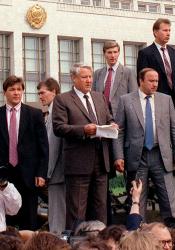Fall of the USSR and Ukrainian Independence
The Ukraine we know today has only been in existence for about thirty years; the fall of the USSR and the end of the Soviet Union led to the independence of many of its previously-held territories – Latvia, Lithuania, Belarus, and Ukraine, to name a few. Throughout Russia’s long and troubled history, there have been multiple factors that built up over time, eventually leading to the collapse of the Union of Soviet Socialist Republics (USSR). Some could argue that the problematic issues stem from all the way back to the rule of Empress Catherine the Great, as mentioned in a previous timeline entry, but no matter what, it can be agreed upon that the USSR was troubled right from the start, back in 1922 after the Russian Revolution. In an attempt to abolish all traces of the previous monarchy and capitalism, the new government that took charge established itself on socialist principles, hoping that would be the solution. “Instead, because of the circumstances of backwardness, the revolution resulted in a dictatorial political regime and an extremely over centralized planned economy” (Sherman 6). This left territories such as Ukraine completely dependent on the motherland, and they never received the support they so desperately needed, leaving everyone even more miserable than before. It is incredible that this flawed system managed to survive for so long – nearly seventy years – but the cracks were only getting wider and wider. Russia was finally caving in on itself, and people were finally coming to the revelation that their elitist and dictatorial form of government simply could not be sustained any longer. The economy was being to fail, and it seemed like the country was facing one disaster after another, including the Cold War with the United States, which was probably the largest factor in the USSR’s eventual fall.
All of this political upheaval was taking place under the leadership of Mikhail Gorbachev. "It was perhaps a paradox that the ruler who presided over the collapse of the Soviet Union was the only one of its ill-starred leaders to leave office with a measure of dignity intact” (“End of the Soviet Union”). When the end was made official, after his removal from office, Gorbachev was replaced by Boris Yeltsin, pictured in the image above, which actually did not go over well with the rest of world: “Ironically, given the course of the Cold War, the Americans wanted to keep the Soviet Union intact…because of the sentiment that Gorbachev was a friend and deserved their support” (Marples 463). It was in this enormous political vacuum he left behind that Ukraine and other territories were able to seize the opportunity to establish their own nationhood, gaining independence for the first time.
It is unfortunate for Russia and Ukraine today that Gorbachev’s level headedness and respectability was not carried on in future Russian leaders, as evidenced by Vladimir Putin. Stuck in the past, Putin continues to hold on to that imperialist mindset that gripped his nation for so long, refusing to let things stay the way they are and instead returning to the dictatorial days of the USSR. His recent attacks on Ukraine only prove that he is unwilling to let go of the failures of the past.
Works Cited
“Boris Yeltzin; collapse of the Soviet Union.” 1991. Encyclopedia Britannica, www.britannica.com/event/the-collapse-of-the-Soviet-Union/images-videos#...
“End of the Soviet Union: The Soviet State, Born of a Dream, Dies.” 26 Dec 1991. The New York Times, www.nytimes.com/1991/12/26/world/end-of-the-soviet-union-the-Soviet-state-born-of-a-dream-dies.html
Marples, David R. “Revisiting the Collapse of the USSR.” Canadian Slavonic Papers / Revue Canadienne Des Slavistes, vol. 53, no. 2/4, 2011, pp. 461–73, www.jstor.org/stable/41708351.
Sherman, Howard J. “Rise and Fall of the Soviet Union.” International Journal of Political Economy, vol. 24, no. 1, 1994, pp. 5–18, www.jstor.org/stable/40470613.
Related Links:
https://editions.covecollective.org/chronologies/karl-marx-and-working-c...

